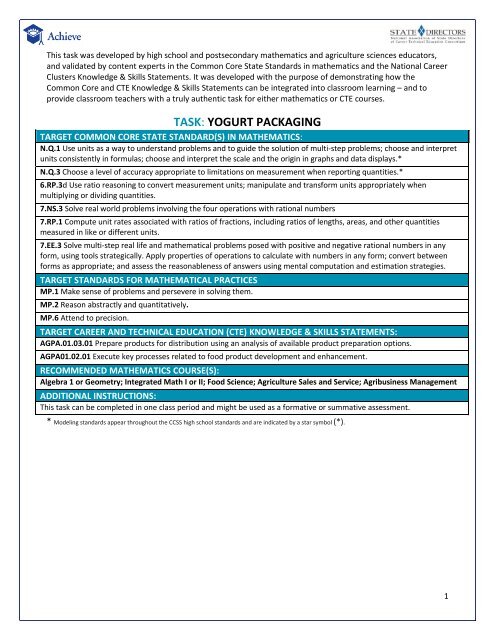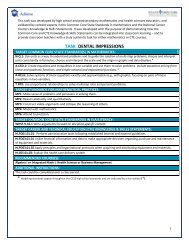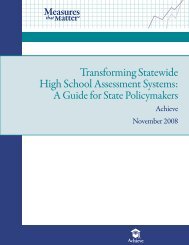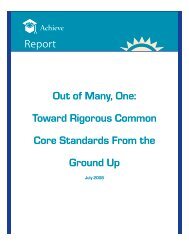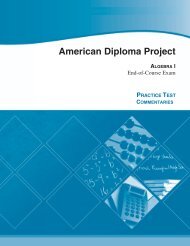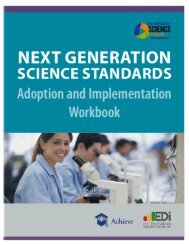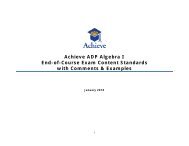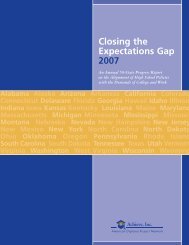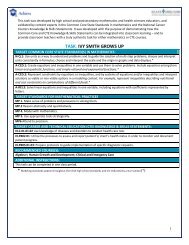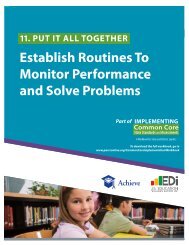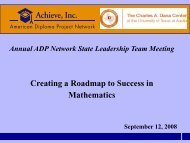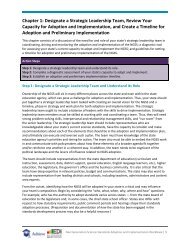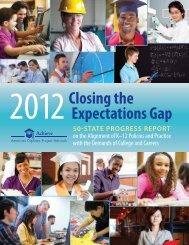Create successful ePaper yourself
Turn your PDF publications into a flip-book with our unique Google optimized e-Paper software.
This task was developed by high school and postsecondary mathematics and agriculture sciences educators,and validated by content experts in the Common Core State Standards in mathematics and the National CareerClusters Knowledge & Skills Statements. It was developed with the purpose of demonstrating how theCommon Core and CTE Knowledge & Skills Statements can be integrated into classroom learning – and toprovide classroom teachers with a truly authentic task for either mathematics or CTE courses.<strong>TASK</strong>: <strong>YOGURT</strong> <strong>PACKAGING</strong>TARGET COMMON CORE STATE STANDARD(S) IN MATHEMATICS:N.Q.1 Use units as a way to understand problems and to guide the solution of multi-step problems; choose and interpretunits consistently in formulas; choose and interpret the scale and the origin in graphs and data displays.*N.Q.3 Choose a level of accuracy appropriate to limitations on measurement when reporting quantities.*6.RP.3d Use ratio reasoning to convert measurement units; manipulate and transform units appropriately whenmultiplying or dividing quantities.7.NS.3 Solve real world problems involving the four operations with rational numbers7.RP.1 Compute unit rates associated with ratios of fractions, including ratios of lengths, areas, and other quantitiesmeasured in like or different units.7.EE.3 Solve multi-step real life and mathematical problems posed with positive and negative rational numbers in anyform, using tools strategically. Apply properties of operations to calculate with numbers in any form; convert betweenforms as appropriate; and assess the reasonableness of answers using mental computation and estimation strategies.TARGET STANDARDS FOR MATHEMATICAL PRACTICESMP.1 Make sense of problems and persevere in solving them.MP.2 Reason abstractly and quantitatively.MP.6 Attend to precision.TARGET CAREER AND TECHNICAL EDUCATION (CTE) KNOWLEDGE & SKILLS STATEMENTS:AGPA.01.03.01 Prepare products for distribution using an analysis of available product preparation options.AGPA01.02.01 Execute key processes related to food product development and enhancement.RECOMMENDED MATHEMATICS COURSE(S):Algebra 1 or Geometry; Integrated Math I or II; Food Science; Agriculture Sales and Service; Agribusiness ManagementADDITIONAL INSTRUCTIONS:This task can be completed in one class period and might be used as a formative or summative assessment.* Modeling standards appear throughout the CCSS high school standards and are indicated by a star symbol (*).1
About the Common Core State Standards in MathematicsThe Common Core State Standards (CCSS) for Mathematics are organized by grade level in grades K–8. At the highschool level, the standards are organized by conceptual category (number and quantity, algebra, functions,geometry, and probability and statistics), showing the body of knowledge students should learn in each category tobe college and career ready, and to be prepared to study more advanced mathematics. The Standards forMathematical Practice describe ways in which developing student practitioners of the discipline of mathematicsincreasingly ought to engage with the subject matter as they grow in mathematical maturity and expertisethroughout the elementary, middle and high school years. www.corestandards.orgAbout the Common Core State Standards in English Language Arts/LiteracyThe Common Core State Standards (CCSS) for ELA/Literacy are organized by grade level in grades K–8. At the highschool level, the standards are organized by 9-10 and 11-12 grade bands. Across K-12 there are four major strands:Reading, Writing, Speaking and Listening, and Language. The CCSS also include Standards for Literacy inHistory/Social Studies, Science, and Technical Subjects, with content-specific (Reading and Writing) literacystandards provided for grades 6-8, 9-10, and 11-12, to demonstrate that literacy needs to be taught and nurturedacross all subjects. www.corestandards.orgAbout the Career Cluster Knowledge and Skill StatementsAs an organizing tool for curriculum design and instruction, Career Clusters provide the essential knowledge andskills for the 16 Career Clusters and their Career Pathways. It also functions as a useful guide in developingprograms of study bridging secondary and postsecondary curriculum and for creating individual student plans ofstudy for a complete range of career options. As such, it helps students discover their interests and their passions,and empowers them to choose the educational pathway that can lead to success in high school, college and career.http://www.careertech.org/career-clusters/resources/clusters/agriculture.html. Although not included in thistemplate, all Clusters and Pathways have Foundational Academic Expectations and Essential Knowledge & SkillsStatements, which, in some cases, overlap with the Common Core State Standards.Fluid ounces, cups, pints, quarts, gallonsGramsRecommended daily allowance (RDA)KEY TERMS2
<strong>YOGURT</strong> <strong>PACKAGING</strong>– The TaskA local food company produces yogurt in ¾ cup tubs.2 cups = 1 pint2 pints = 1 quart4 quarts = 1 gallon16 fl oz = 1 pintShow all your work as you answer the questions below:1. The tubs of yogurt are sold for 75¢ each. Twenty percent of this is profit for the food company. Howmuch profit does the company make on each tub?2. The machine that fills the ¾ cup tubs with yogurt runs 10 hours a day for 5 days a week. It fills 1600tubs an hour. How many gallons of yogurt are needed to fill 1600 tubs?3. How many gallons of yogurt are produced each week?4. What is the percent increase in production if the machine runs for 7 days a week instead of 5 days aweek?5. Each tub of yogurt contains 1.85g of fat. The company would like to reduce this amount by 15%, butinstead of changing the yogurt composition, the company would like to alter the serving size. Howmany fluid ounces will the new container be?6. If 1.85g is 2.85% of the recommended daily allowance (RDA) for fat grams, what is the daily fatrecommendation in grams?7. The new smaller container has what percentage of your daily value of fat?8. Fill in the table below to compare the fat content per fluid ounce of your two products (original andnew sizes) to these competitors. Which brand of yogurt is the lowest fat content per fluid ounce?Make a recommendation for the best (healthiest) brand of yogurt to eat based on your findings.YogurtFat Content Serving Size(grams)(cups)Competitor A 2 g 1 cupCompetitor B 1.45 g 2/3 cupOriginal Tub 1.85 g ¾ cupNew TubServingSize (fl oz)Fat gramsper fl oz% DailyRecommended3
<strong>YOGURT</strong> <strong>PACKAGING</strong> – Possible Solution(s)1. 20% of $0.75 = $0.15 or 15 cents2. 1600 tubs x ¾ cup = 1200 cups of yogurtThere are 16 cups in 1 gallon so 1200 cups / 16 = 75 gallons of yogurt in 1600 tubs.3. (5 days per week)(10 hours per day) = 50 hours per week(75 gallons per hour)(50 hours per week) = 3750 gallons of yogurt are produced per week4. (7 days per week)(10 hours per day) = 70 hours per week(75 gallons per hour)(70 hours per week) = 5250 gallons per week5250 / 3750 = 1.40 or 140%That means there is a 40% increase with the 7-day schedule.5. 1 cup = 8 fluid ounces (oz) so ¾ cup = 6 ozA 15% reduction of fat means the yogurt tub will be 85% of the original amount.85% of 1.85 g of fat = 1.5725 g of fatA proportion can be used to find the new tub size:0.75cupx1.85g1.5725g1.85 x = (0.75)(1.5725)x = 1.79375 / 1.85x = 0.6375 cups = 5.1 oz6. 1.85 g = (2.85%)(F)F = 1.85 g / .0285 = 64.912…g or approximately 65 grams of fat is the daily recommended allowance.7. The new smaller cup has 1.5725 g of fat. The daily recommendation is about 65 grams so that means thesmaller cup is about 2.4% of the daily recommendation.8.YogurtFat Content Serving Size Serving Fat grams % Daily(grams)(cups) Size (fl oz) per fl oz RecommendedCompetitor A 2 g 1 cup 8 oz 0.25 g/oz 3.1%Competitor B 1.45 g 2/3 cup 5.3 oz 0.27 g/oz 2.2%Original Tub 1.85 g ¾ cup 6 oz 0.31 g/oz 2.8%New Tub 1.5725 g 0.6375 cup 5.1 oz 0.31 g/oz 2.4%This comparison shows that Yogurt A has the highest fat content overall but the lowest in fat grams per fluidounce. If lower fat were the goal, then Yogurt B would be best, as it has the lowest % of the dailyrecommendation for fat. Both the Original and New Tubs have the same fat content per fluid ounce and arethe highest for the comparison group.4
<strong>YOGURT</strong> <strong>PACKAGING</strong> – Possible ExtensionsThe extensions below represent potential ways in which mathematics and/or CTE teachers can build on thetask above. All of the extensions are optional and can be used in the classroom, as homework assignments,and/or as long-term interdisciplinary projects.1. Construct a yogurt container for the original tub of yogurt (3/4 cup of yogurt) using paper andincluding the label (conversions required: ounces to cubic unit of measurement). Specify the emptyspace volume (air content).2. Create a marketing and/or advertising plan for your yogurt that uses information about the“competitors’” yogurts to formulate your plan (i.e., fat content). The plan should include a budget andpotential sales projections.3. You want to sell your yogurt abroad. Since other countries use the metric system, calculate thecontainer sizes (in milliliters), using the conversion of 1 fluid ounce = 29.57353 milliliters, for both theoriginal and the new smaller tub. Also determine the number of fat grams per milliliter for each.5
<strong>YOGURT</strong> <strong>PACKAGING</strong>– Appendix: Alignment RatingsThe rating system used in the following charts is as follows:3 EXCELLENT ALIGNMENT:The content/performance of the task is clearly consistent with the content/performance of the Common Core State Standard.2 GOOD ALIGNMENT:The task is consistent with important elements of the content/performance of the CCSS statement, but part of the CCSS is not addressed.1 WEAK ALIGNMENT:There is a partial alignment between the task and the CCSS, however important elements of the CCSS are not addressed in the task.N/A:For Mathematical Practices a content rating does not apply.In the charts C = Content Rating and P = Performance RatingCOLOR KEYBlack = Part of CCSS/K&S Statementaligned to taskGray = Part of CCSS/K&S Statement notaligned to task6
<strong>YOGURT</strong> <strong>PACKAGING</strong>TaskNameAligned CCSSMathematical Practice StandardsC PMP.1 Make sense of problems andpersevere in solving them.MP.2 Reason abstractly andquantitatively.MP.6 Attend to precision.Task-to-Mathematical Practice Alignment Recording SheetN/A 3N/A 2N/A 3Alignment Comments(Standards selection, partial alignments, reasons for rating, etc.)For this task students analyze givens, constraints,relationships, and goals. They must make conjecturesabout the form and meaning of the solution and plan asolution pathway. They must check the reasonablenessof their solution, continually asking themselves, “Doesthis make sense?” The task requires multi-step problemsolving, sense making, and understanding relationships.This task involves quantitative relationships. It requiresthat students make sense of quantities and theirrelationships in the problem situation. They must attendto the meaning of the quantities and pay attention tounits as they represent the quantities and measures in atable. There is no emphasis on abstract reasoning in thistask.For this task students need to attend to units as theyperform calculations and also be careful about specifyingunits in their answers. Rounding and estimation are akey part of the thinking that students must use toaccurately answer the questions.Task Comments(Strengths, weaknesses,possible improvements,effectiveness, etc.)This is a multi-stageproblem with reallife applications andconsiderations.Students mustidentifymeasurements andquantities andperformquantitativecalculations. Theymust show theirwork at each step ofthe process.7
<strong>YOGURT</strong> <strong>PACKAGING</strong>TaskNameTask-to-Common Core State Standards Alignment Recording SheetAligned CCSSContent StandardsC PN.Q.1 Use units as a way to understand problemsand to guide the solution of multi-step problems;choose and interpret units consistently in formulas;choose and interpret the scale and the origin ingraphs and data displays.*N.Q.3 Choose a level of accuracy appropriate tolimitations on measurement when reportingquantities.*6.RP.3d Use ratio reasoning to convert measurementunits; manipulate and transform units appropriatelywhen multiplying or dividing quantities.2 23 33 37.NS.3 Solve real world problems involving the fouroperations with rational numbers. 3 37.RP.1 Compute unit rates associated with ratios offractions, including ratios of lengths, areas, and otherquantities measured in like or different units.3 3Alignment Comments(Standards selection, partial alignments, reasons forrating, etc.)This task does not ask students to interpretunits or to choose the scale and the origin ingraphs or data displays.The task requires rounding in some cases whenexpressing units.This task requires extensive use of ratios toconvert units and proportional reasoning in thesolution of some of the problems.This task represents a real-world situation usingoperations with rational numbers.This task requires students to demonstrate aworking knowledge of conversion and measuresusing fractions and decimals are usedthroughout this task.Task Comments(Strengths, weaknesses,possible improvements,effectiveness, etc.)This complex real-worldtask involves multiplecalculations with workshown to supportresults.7.EE.3 Solve multi-step real life and mathematicalproblems posed with positive and negative rationalnumbers in any form, using tools strategically. Applyproperties of operations to calculate with numbers inany form; convert between forms as appropriate;and assess the reasonableness of answers usingmental computation and estimation strategies.2 2This task does not require students to usenegative rational numbers.* Modeling standards appear throughout the CCSS high school standards and are indicated by a star symbol (*).8
<strong>YOGURT</strong><strong>PACKAGING</strong>TaskNameTask-to-National Career Cluster Knowledge & Skills Statements Alignment Recording SheetAligned National Career Cluster Knowledge &Skills StatementsC P Alignment Comments Task CommentsAGPA.01.03.01 Prepare products for distributionusing an analysis of available productpreparation options.2 1AGPA01.02.01 Execute key processes related tofood product development and enhancement. 1 1The task provides the majority of the informationassociated with preparing products fordistribution, but does reinforce the application ofdifferent considerations of the process.The task tangentially connects to theenhancement of food product development, butfocuses on the base understanding of planningand packaging.The instructional taskintegrates planning andreinforces theimportance ofcalculations in deliveringproducts that meeteconomic thresholdsand customerexpectations.9


